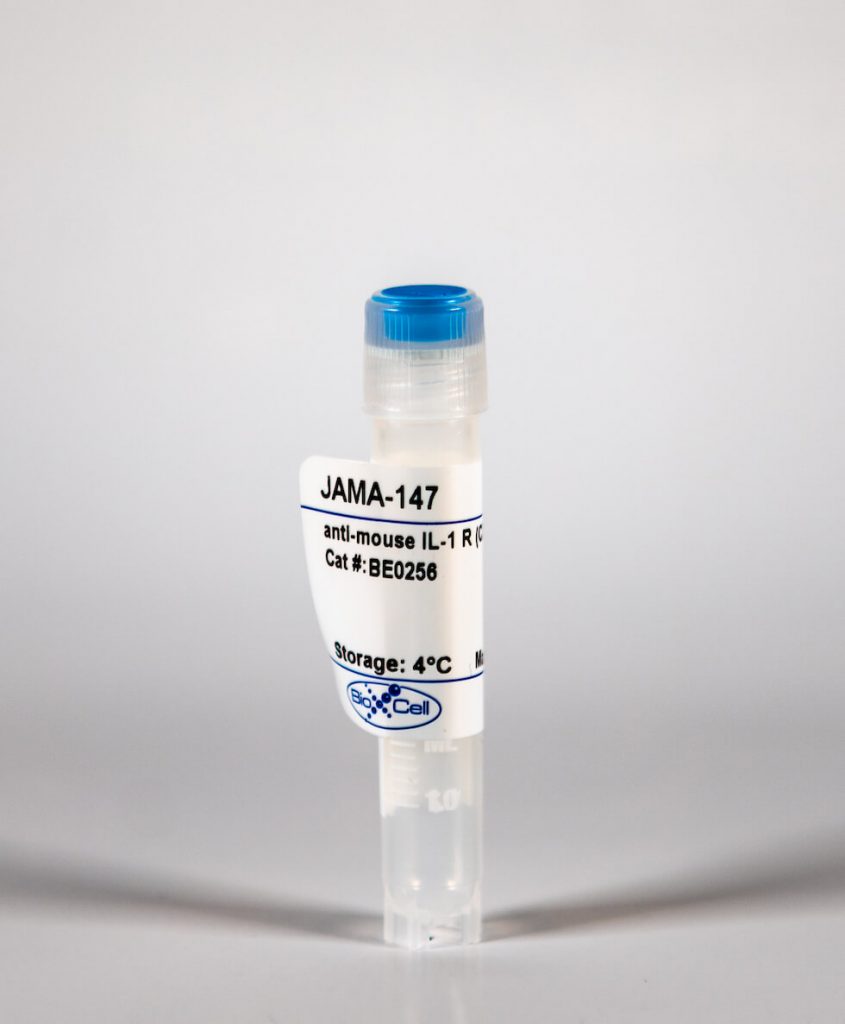InVivoMab anti-mouse IL-1 R (CD121a)
| Clone | JAMA-147 | ||||||||||||
|---|---|---|---|---|---|---|---|---|---|---|---|---|---|
| Catalog # | BE0256 | ||||||||||||
| Category | InVivoMab Antibodies | ||||||||||||
| Price |
|
The JAMA-147 monoclonal antibody reacts with mouse IL-1 receptor (IL-1 R) type 1 also known as CD121a. IL-1 R is an 80 kDa transmembrane glycoprotein and a member of the immunoglobulin superfamily. The receptor is expressed on T cells, thymocytes, dendritic cells, fibroblasts, vascular endothelial cells, epithelial cells and neural cells. IL-1 R type 1 can bind both IL-1α and IL-1β. Upon ligand binding the type I receptor mediates all the known IL-1 biological responses.
| Isotype | Armenian Hamster IgG, κ |
| Recommended Isotype Control(s) | InVivoMAb polyclonal Armenian hamster IgG |
| Recommended Dilution Buffer | InVivoPure™ pH 6.0T Dilution Buffer |
| Immunogen | Extracellular domain of mouse IL-1 R type 1 |
| Reported Applications | in vitro IL-1 R blockade |
| Formulation |
|
| Endotoxin |
|
| Purity |
|
| Sterility | 0.2 μM filtered |
| Production | Purified from tissue culture supernatant in an animal free facility |
| Purification | Protein G |
| RRID | AB_2661843 |
| Molecular Weight | 150 kDa |
| Storage | The antibody solution should be stored at the stock concentration at 4°C. Do not freeze. |
INVIVOMAB ANTI-MOUSE IL-1 R (CD121A) (CLONE: JAMA-147)
Ha, H. L., et al. (2014). “IL-17 drives psoriatic inflammation via distinct, target cell-specific mechanisms.” Proc Natl Acad Sci U S A 111(33): E3422-3431. PubMed
Psoriasis is a chronic inflammatory skin disease characterized by abnormal keratinocyte proliferation and differentiation and by an influx of inflammatory cells. The mechanisms underlying psoriasis in humans and in mouse models are poorly understood, although evidence strongly points to crucial contributions of IL-17 cytokines, which signal via the obligatory adaptor CIKS/Act1. Here we identify critical roles of CIKS/Act1-mediated signaling in imiquimod-induced psoriatic inflammation, a mouse model that shares features with the human disease. We found that IL-17 cytokines/CIKS-mediated signaling into keratinocytes is essential for neutrophilic microabscess formation and contributes to hyperproliferation and markedly attenuated differentiation of keratinocytes, at least in part via direct effects. In contrast, IL-17 cytokines/CIKS-mediated signaling into nonkeratinocytes, particularly into dermal fibroblasts, promotes cellular infiltration and, importantly, leads to enhanced the accumulation of IL-17-producing gammadeltaT cells in skin, comprising a positive feed-forward mechanism. Thus, CIKS-mediated signaling is central in the development of both dermal and epidermal hallmarks of psoriasis, inducing distinct pathologies via target cell-specific effects. CIKS-mediated signaling represents a potential therapeutic target in psoriasis.






